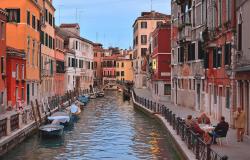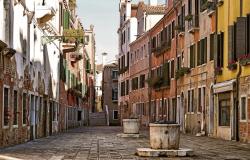
Venetian residents and vacationers saw the city's first new bridge in 70 years start to take shape on Tuesday, as the structure's central section was winched into place.
Now nearing the end of a lengthy construction process, the bridge is expected to open to the public by December 28, according to project director Roberto Casarin.
Once up and running, it will link Venice's railway station with Piazzale Roma, a car and bus terminal on the opposite side of the Grand Canal.
Meanwhile, a temporary walkway of wood is also being erected for engineers and labourers working on the final phase of the project.
Designed by acclaimed Spanish architect Santiago Calatrava, the bridge will be the fourth over the lagoon city's Grand Canal.
A sleek arc of steel accessed by a flight of glass steps, the bridge will span 94 metres from one bank to the other.
But the project has been dogged by controversy and delays, with problems ranging from spiralling costs and alarm over the bridge's weight to protests over the lack of access for the disabled.
An original price tag of four million euros has swelled to 10.7 million euros, while the decision to add an automatic elevator for wheelchairs has bumped the cost up a further 1.44 million euros.
A number of other alterations to the original design have helped up the price and delayed the planned inaguration date of June 2005.
These include the decision to add stairs, in order to make the structure more visible to tourists, and to use two kinds of stone instead of one.
Opponents of the bridge have said the money would have been better spent on the renovation of council buildings to help poorer families and encourage them to remain in the tourist-besieged city.
Hundreds of protesters turned out last week to contest the bridge, led by two centre-right opposition parties, the National Alliance and the Northern League.
Organisers said the demonstration drew 1,500 people but police said many of them were simple spectators who wanted to watch while the central span was moved up the canal.
Calatrava, who also designed the 2004 Athens Olympic stadium, recently issued an angry statement rejecting fears that the banks of the Grand Canal might not be able to bear the bridge's weight.
He said the weight of the bridge would be borne by foundations set into solid terrain, far below the banks, in a "resilient layer of stone and earth compacted and hardened by hydraulic cylinders".
The architect, whose other trademark buildings include an auditorium and sealife centre in his native Valencia and the Milwaukee Museum of Fine Arts, also stressed the project delays and rising costs had nothing to do with him.













